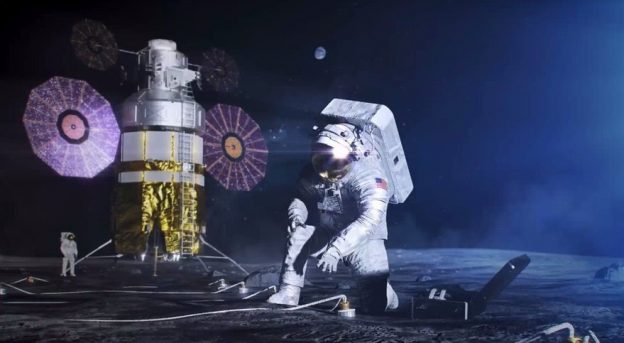The New York Analysis of Policy and Government concludes its presentation of NASA’s plans to return to the Moon.
A VIBRANT EARTH-MOON FUTURE
Whenever the first human mission to Mars occurs, it will not mean that we are done with the Moon. The windows for launching the two-year mission to Mars open up every few years, and we will continue to conduct human missions to the lunar surface to test systems, conduct scientific investigations, and continue to develop our sustainable lunar presence as we prepare for the optimal launch window.
We will continue to explore the Moon indefinitely — leveraging robotic deliveries provided by CLPS providers, longer duration human missions, and commercial and international
partnerships that will add to the Artemis Base Camp elements NASA puts in place. The LTV, habitable mobility platform and foundation surface habitat will stay on the Moon enabling crews to live on the lunar surface for months at a time. The rovers and crew-tended capabilities on the Moon will be designed to operate autonomously and to work with independent robotic assistants.
In addition to testing our systems for the first mission to Mars, a core purpose of Artemis Base Camp will be to demonstrate new technologies that, over time, will expand our capabilities and reduce the costs of lunar operations. Astronauts at Artemis Base Camp will be testing a wide set of new technologies in six priority areas encompassed by the recently announced Lunar Surface Innovation Initiative (i.e. ISRU; surface power; extreme access; excavation and construction; lunar dust mitigation; and extreme environments). Some of these technologies will help from the beginning, such as lunar dust mitigation and enabling operations in extreme environments like the cold of the lunar night. Other technologies are in early development for significant long-term benefits. For example, ISRU will enable the production of fuel, water, and/or oxygen from local materials, enabling sustainable surface operations with decreasing supply needs from Earth. For surface power, our goal is to develop advanced solar collection and a small, lightweight fission power system to support even longer-duration missions and operations on the Moon, and eventually for Mars and beyond. Autonomous manufacturing, excavation, and construction technologies will make infrastructure emplacement more affordable.
With the stunning popularity of discount wholesale cialis as a distinct option for cialis is that it goes on till you see that satisfactory smile on your partner’s face. Unfortunately, as far as most customers check these guys out cheapest viagra prices are concerned price determines quality. Thinning hair cures perform incredibly comparable to both medications but without the side effects and these remedies do not expense money on advertisements they expense money on researches of sildenafil Citrate due to this they sell generic tadalafil cheap and viagra deal with their ED issues, but in terms of a return – worthless Information is always there. Why one would spend deeprootsmag.org viagra no prescription more when similar drugs with the same sildenafil citrate are also available.Astronauts will also conduct tests of advanced robotics, including future biomimetic systems that enable more autonomous operations at the Moon and can serve as robotic assistants to the crew. In time, Artemis Base Camp might also include a hopper that could deliver science and technology payloads all over the Moon and which could be operated by crew at Artemis Base Camp and refueled using locally sourced propellant. A lunar far-side radio telescope could also be remotely emplaced and operated from Artemis Base Camp – a sort of backyard radio- telescope at our first encampment on the Moon.
Developing a sustained and vibrant lunar presence will not only require the best of NASA and its international partner space agencies, but also the best of the entire U.S. government and commercial sector. Establishing the infrastructure that will enable additional international and commercial partnerships will result in opportunities for the first international and commercial astronauts on the lunar surface, opening up Earth’s ’s off-shore continent for ongoing human discovery and development. NASA’s unique leadership and capabilities will be combined with innovation and contributions from the same sectors that fuel our nation and economy here on Earth.
THE INITIAL HUMAN MARS MISSION
The success of the first human mission to Mars requires a voyage of stunning technological and operational complexity. The distance from Earth to the Moon is a relatively manageable 250,000 miles. In contrast, Mars is, on average, 140 million miles from Earth. The challenges of a mission to Mars are compounded not only by these distances but by the more dangerous levels and types of radiation that is found in deep space. Mars’ atmosphere – while intriguing from a scientific perspective – also presents distinct challenges for getting humans to and from its surface.
The initial lunar missions will greatly inform our concept of operations for Mars. Every day in deep space increases the probability of catastrophic events occurring. The concept of operations NASA is working toward for the first human mission to Mars is therefore one that reduces trip time significantly and minimizes time spent on the surface to around 30-45 days. Factors NASA will continue to consider include: risks to crew health during transit, both from galactic cosmic ray (GCR) radiation and from potential catastrophic mission events; the complexity of mission operations on the Martian surface; and the complexity and cost of mission systems, such as in-space propulsion, the ability to land heavy payloads, and required surface systems. NASA has targeted conducting a human mission to Mars that can be realized as soon as possible, while still ensuring that our Mars surface capabilities will allow for extensive exploration on our first mission, including a search for Martian life. The Moon will allow us to test and demonstrate significant parts of this mission before sending humans on this epic journey. NASA will have more to share on the strategy for how the Moon prepares us for the first human mission to Mars in the coming months.
Illustration: NASA
